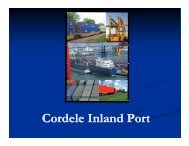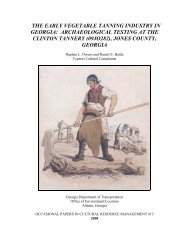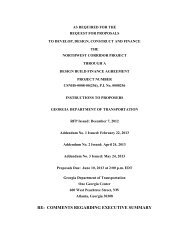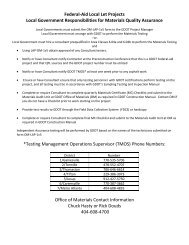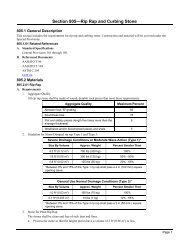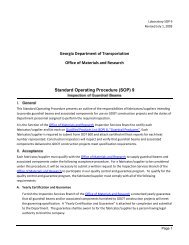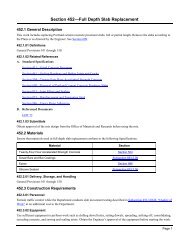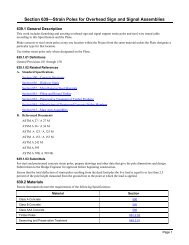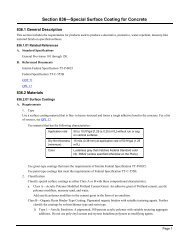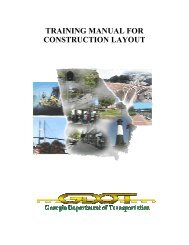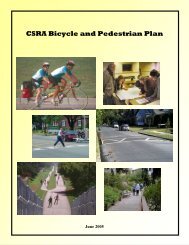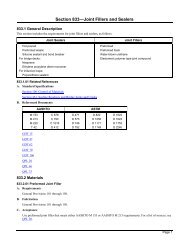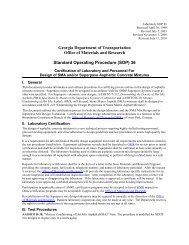Section 894 Fencing
Section 894 Fencing
Section 894 Fencing
Create successful ePaper yourself
Turn your PDF publications into a flip-book with our unique Google optimized e-Paper software.
<strong>Section</strong> <strong>894</strong>—<strong>Fencing</strong><br />
<strong>894</strong>.1 General Description<br />
This section includes the requirements for the following types of fence and fencing accessories:<br />
Chain link fence<br />
Woven wire fence<br />
Barbed wire<br />
Ground rods<br />
Field fencing<br />
Silt fabric fencing<br />
<strong>894</strong>.1.01 Related References<br />
A. Standard Specifications<br />
<strong>Section</strong> 862—Wood Posts and Bracing<br />
<strong>Section</strong> 881—Fabrics<br />
B. Referenced Documents<br />
ASTM<br />
AASHTO<br />
A 116<br />
A 392<br />
A 817<br />
M 181<br />
A 121<br />
A 491<br />
A 824<br />
A 123/ A 123 M<br />
A 584<br />
F 626<br />
A 153/ A 153M<br />
A 585<br />
F 1043<br />
A 239<br />
A 702<br />
F 1083<br />
<strong>894</strong>.2 Materials<br />
<strong>894</strong>.2.01 Chain Link Fence<br />
A. Requirements<br />
Ensure that zinc or aluminum coated steel fabric, fittings, accessories, and posts for chain link fence meet the following<br />
requirements.<br />
1. Fence Fabric<br />
Use woven wire with reasonably uniform 2 in (50 mm) square mesh. Ensure that the mesh has parallel sides and<br />
horizontal and vertical diagonals of uniform dimensions. Use the wire size specified on the Plans or in the Proposal.<br />
a. Zinc Coated: Use steel fabric that meets the requirements of ASTM A 392. Ensure that the wire and hot-dip<br />
coating meet the requirements of ASTM A 817 Type II, Class 1.<br />
b. Aluminum Coated: Use steel fabric that meets the requirements of ASTM A 491. Ensure the wire and coating<br />
meets the requirements of ASTM A 817, Type I.<br />
2. Fittings and Accessories<br />
a. Tension Wire: Use wire that meets the requirements of ASTM A 824 Type I for aluminum coated fabric, or<br />
Type II, Class 2 for hot-dipped, zinc-coated fabric.<br />
b. Fittings: Use fittings that meet the requirements of ASTM F 626.<br />
Page 1
<strong>Section</strong> <strong>894</strong>—<strong>Fencing</strong><br />
1) Ensure fittings or accessories not included in ASTM F 626 meet industry standards for heavy, industrialtype<br />
fences.<br />
2) Hot-dip the materials in zinc with at least 1.2 oz./ft² (365 g/m²) of surface area. If applicable, you may<br />
make the materials from Aluminum Alloy 360, die-cast, or Sand Alloy 356, ZG61A, or Tenzalloy.<br />
3) Use bolts and nuts that meet industry standards and are zinc coated with the hot-dip process according to<br />
ASTM A 153/A 153 M.<br />
3. Posts, Rails, and Braces<br />
Use posts, rails, and braces that meet the requirements of ASTM F 1043, Table 2, Group IA, IC, II, or III..<br />
a. Group IA, II, and III posts to be used with zinc coated or aluminum coated chain link fence shall meet the<br />
coating requirements of ASTM F 1083.<br />
b. Group IC posts to be used with zinc coated or aluminum coated chain link fence shall be coated according to<br />
AASHTO M 181 <strong>Section</strong> 32.3.<br />
c. Check the Plans for specifications on posts used for special applications. Use special posts that meet the<br />
requirements of ASTM F 1083 or are approved by the Office of Materials and Research.<br />
4. Gates<br />
Use support posts and gate frames as designated on the Construction Detail or Project Plans. Use gate materials that<br />
meet the requirements of Subsection <strong>894</strong>.2.01.A.3.<br />
B. Fabrication<br />
a. Use the same coating requirements as for the fence posts. Coat gate frames after completing all welding.<br />
b. Use fittings and hinges that meet the requirements of Subsection <strong>894</strong>.2.01.A.2.b.<br />
Ensure that the chain link fence fabric is produced by recognized, good commercial practices.<br />
1. Apply the zinc or aluminum coating to the fabric in a continuous process. Do not apply in roll form.<br />
2. Carefully inspect the coated fabric visually, both before and after weaving, to determine the coating quality.<br />
C. Acceptance<br />
The Department will reject chain link fabric that has excessive roughness, blisters, sal ammoniac spots, bruises, flaking,<br />
bare spots, or other obvious defects to any considerable extent.<br />
D. Materials Warranty<br />
General Provisions 101 through 150.<br />
<strong>894</strong>.2.02 Woven Wire Fence<br />
A. Requirements<br />
1. Fabric<br />
Use fabric that meets the requirements of ASTM A 116, Design Number 1047-6-11, with Class 3 coating.<br />
a. Ensure that the galvanizing is uniform.<br />
b. Ensure that less than 5 percent of the joints are deficient in zinc coating, as determined by ASTM A 239.<br />
c. You may use aluminum coated steel that meets the requirements of ASTM A 584, Design Number 1047-6-11,<br />
for the woven wire fence fabric.<br />
2. Posts<br />
Use steel or wood posts of the sizes shown on the Plans.<br />
a. Use wood posts that meet the requirements of Subsection 862.2.01.<br />
b. Use steel posts and bracing that meet the requirements of ASTM A 702. Galvanize posts and braces with the<br />
hot-dip method according to ASTM A 123/A 123M.<br />
Page 2
<strong>Section</strong> <strong>894</strong>—<strong>Fencing</strong><br />
3. Certification<br />
Furnish a certification to the Engineer from the manufacturer that shows the physical properties of the materials.<br />
4. Accessories<br />
Galvanize the following accessories according to ASTM A 153/ A 153M. Use 0.80 oz./ft² (245 g/m²) as the<br />
galvanizing minimum. Galvanize other accessories as necessary or specified on the Plans.<br />
a. Wire Fasteners: Use fasteners that meet the requirements of ASTM A 702.<br />
b. Tension Wire: Use No. 11 gauge wire.<br />
c. Staples: Use No. 9 gauge staples 1-1/2 in (38 mm) long.<br />
d. Nails: Use 1 in (25 mm) roofing nails to fasten metal caps to wooden posts.<br />
5. Gates<br />
B. Fabrication<br />
Use support posts and gate frames of the size designated on the Construction Detail or Project Plans.<br />
a. Use a frame that is an all welded unit. Ensure that the gate is galvanized after welding with 2 oz./ft² (610 g/m²)<br />
of spelter coating.<br />
b. Use hinges, latches, and other accessories of good commercial quality that are coated as in<br />
Subsection <strong>894</strong>.2.02.A.4.<br />
1. Ensure that the woven wire fence fabric is produced by methods recognized as good commercial practices.<br />
2. Carefully inspect the galvanized fabric to determine the zinc coating quality.<br />
C. Acceptance<br />
The Department will reject woven wire fabric that has excessive roughness, blisters, sal ammoniac spots, bruises,<br />
flaking, bare spots, or other obvious defects to any considerable extent.<br />
D. Materials Warranty<br />
General Provisions 101 through 150.<br />
<strong>894</strong>.2.03 Barbed Wire<br />
A. Requirements<br />
1. Galvanized Steel Barbed Wire<br />
Use wire that meets the requirements of ASTM A 121 and has a Class 3 zinc coating.<br />
2. Aluminum Coated Steel Barbed Wire<br />
Use wire that meets the requirements of ASTM A 585.<br />
3. Posts<br />
B. Fabrication<br />
Use posts as specified in Subsection <strong>894</strong>.2.02.A.2 for barbed wire fence.<br />
General Provisions 101 through 150.<br />
C. Acceptance<br />
General Provisions 101 through 150.<br />
D. Materials Warranty<br />
General Provisions 101 through 150.<br />
Page 3
<strong>Section</strong> <strong>894</strong>—<strong>Fencing</strong><br />
<strong>894</strong>.2.04 Ground Rods<br />
A. Requirements<br />
1. Use ground rods that are 9/16 to 5/8 in (14 to 16 mm) diameter and at least 8 ft (2.4 m) long, unless otherwise shown<br />
on the Plans.<br />
2. Ensure that the ground rods are galvanized steel with a minimum coating of 2 oz./ft² (610 g/m²) according to the<br />
requirements of ASTM A 153/ A 153M.<br />
B. Fabrication<br />
General Provisions 101 through 150.<br />
C. Acceptance<br />
General Provisions 101 through 150.<br />
D. Materials Warranty<br />
General Provisions 101 through 150.<br />
<strong>894</strong>.2.05 Field <strong>Fencing</strong> (Woven Wire and Barbed Wire)<br />
A. Requirements<br />
1. Definition<br />
Field fencing designates replacement fencing outside the Right of Way or temporary fencing inside the Right of<br />
Way, provided you do not reuse the materials for permanent fencing inside the Right of Way.<br />
2. Fence fabric<br />
Use woven wire fabric that meets the requirements of ASTM A 116 Design No. 939-6-12-1/2, and has a Class I<br />
coating, unless otherwise designated.<br />
3. Barbed wire<br />
Use wire that meets the requirements of ASTM A 121 and has a Class I coating. Use the same number of barbed<br />
wire strands as the existing or replaced fence, or as specified in the Plans.<br />
4. Posts<br />
Use either galvanized steel, painted steel, or treated timber of the dimensions and spacing shown on the Construction<br />
Detail or Plans.<br />
5. Gates<br />
Use posts, frame material, hinges, and fittings of acceptable commercial quality. Get approval from the Engineer<br />
before use.<br />
6. Use the Special Plan Details and/or Special Provisions for any special design of the field fence.<br />
B. Fabrication<br />
General Provisions 101 through 150.<br />
C. Acceptance<br />
1. Get approval from the Engineer for all materials. Ensure that the materials are of an acceptable commercial quality<br />
and are equivalent in quality to the fence being replaced or to the existing fence, as applicable.<br />
2. Do not send materials to the laboratory unless requested by the Engineer or required by the Plans.<br />
D. Materials Warranty<br />
General Provisions 101 through 150.<br />
Page 4
<strong>Section</strong> <strong>894</strong>—<strong>Fencing</strong><br />
<strong>894</strong>.2.06 Silt Fabric <strong>Fencing</strong><br />
A. Requirements<br />
1. Fabric<br />
a. See Subsection 881.2.07, “Silt Fence Filter Fabric,” for the types of fabric available.<br />
b. Use a woven wire support fence with Type “C” fence.<br />
2. Posts<br />
1) Ensure that the wire fence fabric is at least 32 in (810 mm) high with at least 6 horizontal wires.<br />
2) Ensure that the vertical wires have a maximum spacing of 12 in (155 mm).<br />
3) Ensure that the top and bottom wires are at least 10 gauge (2.49 mm) and all other wires are at least 12-1/2<br />
gauge (2.03 mm).<br />
4) You may use other designs subject to approval by the Office of Materials and Research.<br />
Use post sizes and types as determined by the type of fence being installed. Generally hardwood posts will be<br />
limited to ash, hickory, or oak. Other hardwoods may be acceptable if approved by the Office of Materials and<br />
Research.<br />
a. Type “A” Fence: Use either wood or steel posts that are at least 4 ft (1.2 m) long.<br />
1) If using soft wood, use posts that are at least 3 in (75 mm) in diameter or nominal 2 x 4 in (33 x 89 mm)<br />
and straight enough to provide a fence without noticeable misalignment.<br />
2) If using hardwood, use posts that are 1-1/2 x 1-1/2 in (38 x 38 mm) with a minus tolerance of 1/4 in (6 mm)<br />
providing the cross sectional area is at least 2.25 in² (1440 mm²).<br />
3) If using steel, use posts that are “U,” “T,” or “C” shaped with a minimum weight of 1.15 lb/ft (1.7 kg/m),<br />
and have projections for fastening the fence to the posts.<br />
b. Type “B” Fence: Use either wood or steel posts that are at least 3 ft (900 mm) long.<br />
1) If using soft wood, use posts that are at least 2 in (50 mm) in diameter or nominal 2 x 2 in (33 x 33 mm).<br />
2) If using hardwood, use posts that are 1 x 1 in (25 x 25 mm) with a minus tolerance of 1/ 4 in (6 mm)<br />
providing the cross sectional area is a minimum of 1 in² (625 mm²).<br />
3) If using steel posts, use types “U,” “T,” or “C” shapes with a minimum weight of 0.75 lb/ft (1.1 kg/m).<br />
c. Type “C” Fence: Use only steel posts that are at least 5 ft (1.5 m). Use “U,” “T,” or “C” shaped posts with a<br />
minimum weight of 1.15 lb/ft (1.7 kg/m). Use posts that have projections for fastening the woven wire and filter<br />
fabric.<br />
NOTE: You must use woven wire to provide extra support for Type “C” fence installations.<br />
3. Fasteners for Wooden Posts<br />
B. Fabrication<br />
a. Wire Staples: Use staples that are at least 17 gauge (1.37 mm), legs at least 1/2 in (13 mm) long, and a crown at<br />
least 3/4 in (19 mm) wide.<br />
b. Nails: Use nails that are at least 14 gauge (2.03 mm), 1 in (25 mm) long, with button heads of at least 3/4 in<br />
(19 mm).<br />
General Provisions 101 through 150.<br />
C. Acceptance<br />
General Provisions 101 through 150.<br />
Page 5
<strong>Section</strong> <strong>894</strong>—<strong>Fencing</strong><br />
D. Materials Warranty<br />
General Provisions 101 through 150.<br />
Page 6



